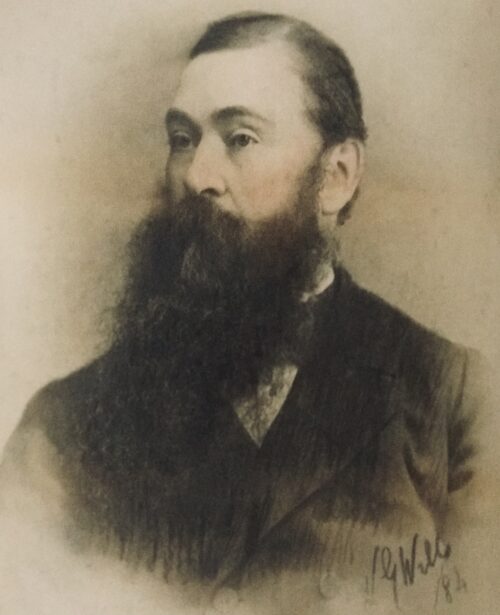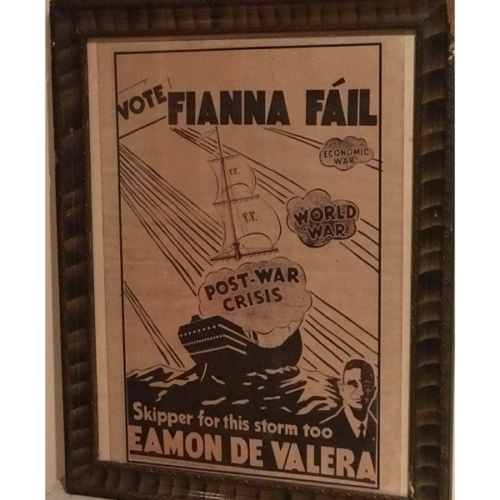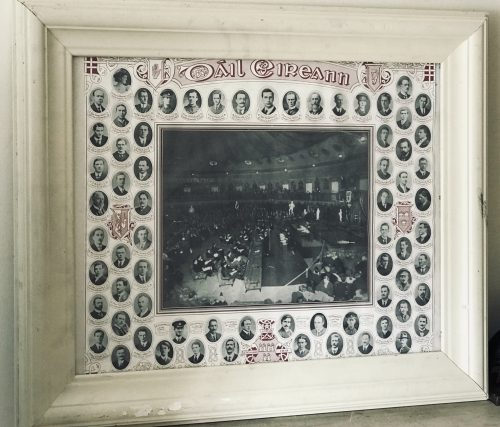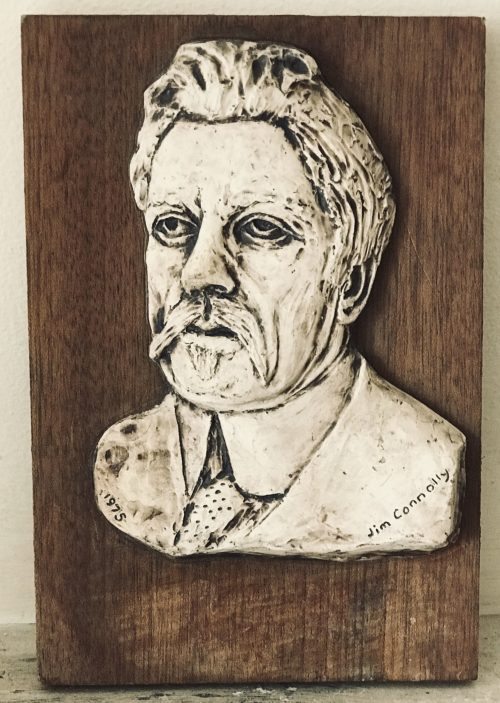Charming recruitment poster from 1929 urging “male citizens of good character resident within the Dublin Metropolitan Area ‘to turn up for recruitment at Portobello Barracks on Monday 11th November 1929.
Ranelagh Dublin 49cm x 42cm
Early Reserve/Volunteer forces
In the years following the establishment of the Defence Forces, various classes of Army Reserves were experimented with. Between 1927 and 1939, these comprised several reserve classes.
Classes
In May 1927, the “Class A Reserve” was established and consisted of regular non-commissioned officers (NCOs) and men transferred to the Reserve. Though numbers never exceeded 5,000, they were the best trained of the reserves, with over 80% reporting annually for training.
In January 1928, the “Class B Reserve” was formed, with the object of building up the infantry arm of the Defence Forces – on a voluntary basis. Its conditions of service were three months initial training, followed by one months’ annual training with liability for six years Reserve service. It was not a success however, never exceeding 3,600 in strength, and had practically ceased to exist by 1934.
The “Volunteer Reserve Force” was established in Autumn 1929. No initial training was required – instead members attended parade once weekly, with four weekend camps per year along with fifteen days annual training. It was divided into three units, one Battalion in Dublin, an Artillery Battery in Cork and an Officer Training Corps in third-level universities. A total of 1,229 enlisted in the Officer Training College (OTC), while 987 enlisted in the other two units. The units were disbanded in 1935.
The “Volunteer Force” was established in March 1934. Apart from basic military requirements there was a political consideration in its formation. Fianna Fáil, who had assumed power in 1932, were anxious that the Army should be more representative of the different political persuasions in the country. Since 1924, the Army had been composed of pro-Treaty supporters. It was hoped that this new force would attract men who would be considered anti-Treaty in outlook. To this end a number of men who had prominent anti-Treaty records in the Civil War were commissioned at the initial stages as Administrative Officers.
On 6 November 1935 the “Pearse Regiment” was added. Named after Pádraig Pearse, this force consisted of three lines of Reserve with varying conditions of service. Those of the first line had to undergo initial training along with a commitment to thirty days annual training, and reached a maximum strength of 10,578 by April 1935. On 1 September 1939 the strength was 257 officers and 6,986 other ranks. The second line consisted of personnel who had been trained in the first line and had been transferred. The third line was intended to be a reserve of specialists in civilian life who would be of value to the Army upon mobilisation.
Organisation
The Volunteer Force was the first scheme to make provision for recruitment into all arms of the service. It also provided for the special training of non-commissioned officers and the training of NCOs for commissions. The inclusion of civilian committees (known as Sluaghs) to help recruiting and administration at a local level was a feature of the Force. The Sluaghs however gradually disappeared and were replaced by committees composed solely of Volunteers. The Volunteers had a distinctive uniform, darker than the ordinary uniform, with black boots, leggings, belts, chromium buttons and badges and forage caps.
Territorially these early volunteer/reserve forces were divided into regimental areas, which took their names from the ancient Irish kingdoms where they were raised;
- The Regiment of Oriel – Counties Louth, Meath and Monaghan.
- The Regiment of Leinster – Counties Kildare, West Wicklow, Wexford and Carlow.
- The Regiment of Dublin – County and Borough of Dublin and East Wicklow.
- The Regiment of Ormond, renamed Ossory in 1935. Counties Kilkenny, Waterford and Tipperary.
- The Regiment of Thomond – Counties Limerick and Clare.
- The Regiment of Connacht – Counties Galway, Mayo and Roscommon.
- The Regiment of Breffni – Counties Cavan, Longford, Leitrim and Sligo.
- The Regiment of Tyrconnell – County Donegal.
- The Regiment of Uisneach – Counties Laois, Offaly and Westmeath.
- The Regiment of Desmond – Counties Cork and Kerry.
World War II – “The Emergency”
In response to the various security threats posed during World War II, known in Ireland as The Emergency, a new reserve force – the Local Security Force (LSF) – was created on 28 May 1940 as an auxiliary police service. Instituted under a Garda Síochána Act, its activities were to be devoted to auxiliary police and internal security work. Recruiting forms were dispatched to Garda stations on 31 May 1940 and by 16 June of the same year 44,870 members were enrolled.
On 22 June 1940 a decision was taken to divide the force into two groups;
- “A” Group – to act as an auxiliary to the Army.
- “B” Group – to continue as an auxiliary to the Police Force.
By August 1940 the strength had risen to 148,306 and by October of the same year detailed organisations for each group were issued and District Staffs were formed. By the end of 1940 the Army had more or less completed its expansion to a war-time footing and was then in a position to take over the control of “A” Group from the Gardaí. On 1 January 1941 it was handed over to the Command and control of the Army and was given the new title of “The Local Defence Force”/”LDF” (An Fórsa Cosanta Áitiúil/FCÁ).
The “B” Group continued as an auxiliary police force and retained its old name – “The Local Security Force” (LSF). From the military point of view the LDF was the equivalent of many additional battalions to the Defence Forces.
Local Security Force
The LSF was organised in groups around each Garda Station. It was organised into sections and squads and its general duties consisted of traffic control, communications, protective duties, transport, and first aid.
While other elements of the Defence Forces devoted most of their time to training, the LSF, while training was important, were required to devote much of their time to actual work. Police duties, patrolling and observation were important aspects of their activities. Unlike the soldier who was trained to act as part of a team, the LSF member acted more like a policeman and therefore more emphasis was placed on training to enable him to act alone.
In the cities and large towns their systems of patrols and beats were designed to coincide with times of local crime peaks. A survey of 200 commendations issued to members include the detection of such crimes as housebreaking, larceny, dangerous driving, saving of life from burning buildings, assistance to Gardaí in need of assistance and others.
They also assisted the Gardaí in searches for reported parachutists, missing persons, and crashed aircraft. They kept a watch for floating mines and provided cordons when required. They also assisted in policing at two General Elections. Assistance to other Government Departments was also provided, and included the distribution to households of tea rationing forms and ration books (March 1941), census of turf cutting (July 1941), a survey of accommodation available for refugees, and the provision of patrols to enforce the regulations governing the movement of cattle on outbreak of foot-and-mouth disease.
Local Defence Force
As noted above, this was the “A” Group of the LSF that had been transferred to the Army in January 1941. With its military status and responsibility, it was integrated into the combat organisations under full military discipline. The main LDF weapons were the rifle, bayonet and grenade. The organisation was mostly one of rifle companies and platoons.
In 1942 the LDF strength was 98,429. In 1943 this rose to 103,530. And in 1944 it was at 96,152. These strengths were regarded as being effective and may reflect a rise and fall as the European battle front approached or receded from Irish shores.
Establishment of the FCÁ
A post-war establishment of 12,500 in all ranks saw a rapid demobilisation and reorganisation within a small period. The Regular Army was now composed of three Brigades. In 1947 all reserve forces were disestablished and in their place were created the First Line Reserve (FLR) and the Second Line Reserve – An Fórsa Cosanta Áitiúil (FCÁ) (Local Defence Force).
The basic principles underlying this establishment were that;
- The three brigades at about half strength could, with their reserves be quickly mobilised to full strength.
- Provide normal garrison and training establishments.
- Provide cadres for the Reserves.
This organisation remained until 1959 when “integration” was introduced by which the FCÁ was integrated with the Regular Army. Six Brigades of mixed Regular and FCÁ units, each with only one Regular Battalion were established with the intention that the remaining units would be filled by FCÁ personnel upon mobilisation.
In 1979 there was a change in the structure and role of the FCÁ which had existed since the 1959 integration.
The six integrated Infantry Brigades were reduced to four Permanent Defence Force (PDF) Brigades and the Eastern Command Infantry Force (ECIF). A new command structure was set up for the FCÁ with a Directorate of Reserve Forces.
The Army Reserve was deployed to aid its regular counterparts in support of the Garda Síochána along the border with Northern Ireland during the conflict known as the Troubles (1969–1998).







